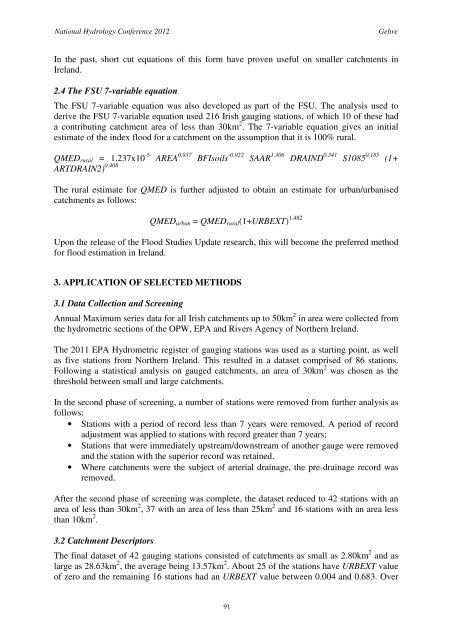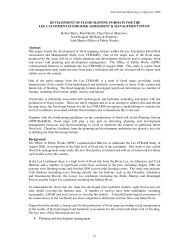09 - flood estimation in small and urbanised catchments in ireland
09 - flood estimation in small and urbanised catchments in ireland
09 - flood estimation in small and urbanised catchments in ireland
Create successful ePaper yourself
Turn your PDF publications into a flip-book with our unique Google optimized e-Paper software.
National Hydrology Conference 2012<br />
Gebre<br />
In the past, short cut equations of this form have proven useful on <strong>small</strong>er <strong>catchments</strong> <strong>in</strong><br />
Irel<strong>and</strong>.<br />
2.4 The FSU 7-variable equation<br />
The FSU 7-variable equation was also developed as part of the FSU. The analysis used to<br />
derive the FSU 7-variable equation used 216 Irish gaug<strong>in</strong>g stations, of which 10 of these had<br />
a contribut<strong>in</strong>g catchment area of less than 30km 2 . The 7-variable equation gives an <strong>in</strong>itial<br />
estimate of the <strong>in</strong>dex <strong>flood</strong> for a catchment on the assumption that it is 100% rural.<br />
QMED rural = 1.237x10 -5 AREA 0.937 BFIsoils -0.922 SAAR 1.306 DRAIND 0.341 S1085 0.185 (1+<br />
ARTDRAIN2) 0.408<br />
The rural estimate for QMED is further adjusted to obta<strong>in</strong> an estimate for urban/<strong>urbanised</strong><br />
<strong>catchments</strong> as follows:<br />
QMED urban = QMED rural (1+URBEXT) 1.482<br />
Upon the release of the Flood Studies Update research, this will become the preferred method<br />
for <strong>flood</strong> <strong>estimation</strong> <strong>in</strong> Irel<strong>and</strong>.<br />
3. APPLICATION OF SELECTED METHODS<br />
3.1 Data Collection <strong>and</strong> Screen<strong>in</strong>g<br />
Annual Maximum series data for all Irish <strong>catchments</strong> up to 50km 2 <strong>in</strong> area were collected from<br />
the hydrometric sections of the OPW, EPA <strong>and</strong> Rivers Agency of Northern Irel<strong>and</strong>.<br />
The 2011 EPA Hydrometric register of gaug<strong>in</strong>g stations was used as a start<strong>in</strong>g po<strong>in</strong>t, as well<br />
as five stations from Northern Irel<strong>and</strong>. This resulted <strong>in</strong> a dataset comprised of 86 stations.<br />
Follow<strong>in</strong>g a statistical analysis on gauged <strong>catchments</strong>, an area of 30km 2 was chosen as the<br />
threshold between <strong>small</strong> <strong>and</strong> large <strong>catchments</strong>.<br />
In the second phase of screen<strong>in</strong>g, a number of stations were removed from further analysis as<br />
follows:<br />
• Stations with a period of record less than 7 years were removed. A period of record<br />
adjustment was applied to stations with record greater than 7 years;<br />
• Stations that were immediately upstream/downstream of another gauge were removed<br />
<strong>and</strong> the station with the superior record was reta<strong>in</strong>ed.<br />
• Where <strong>catchments</strong> were the subject of arterial dra<strong>in</strong>age, the pre-dra<strong>in</strong>age record was<br />
removed.<br />
After the second phase of screen<strong>in</strong>g was complete, the dataset reduced to 42 stations with an<br />
area of less than 30km 2 , 37 with an area of less than 25km 2 <strong>and</strong> 16 stations with an area less<br />
than 10km 2 .<br />
3.2 Catchment Descriptors<br />
The f<strong>in</strong>al dataset of 42 gaug<strong>in</strong>g stations consisted of <strong>catchments</strong> as <strong>small</strong> as 2.80km 2 <strong>and</strong> as<br />
large as 28.63km 2 , the average be<strong>in</strong>g 13.57km 2 . About 25 of the stations have URBEXT value<br />
of zero <strong>and</strong> the rema<strong>in</strong><strong>in</strong>g 16 stations had an URBEXT value between 0.004 <strong>and</strong> 0.683. Over<br />
91
















